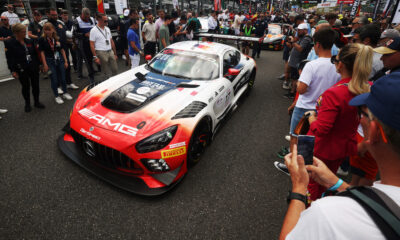
Photo: BMW
BMW opted against the use of its M8 GTE engine to power its LMDh car after it discovered that the base engine was both too large and too heavy to be used, according to its chief drivetrain engineer.
BMW Motorsport boss Andreas Roos confirmed in late May that the German manufacturer chose the P66 V8 engine, which had been in use in DTM in 2017-18.
Roos stated at the time that this particular engine had been chosen after ‘an investigation’ which saw BMW look at various engine types including the P48 engine used in DTM in 2019-20, as well as the V8 engine that powered the M8 GTE in the FIA World Endurance Championship and IMSA WeatherTech SportsCar Championship.
While Roos at the time did not go into specifics as to why the M8 powertrain was dropped in favor of the DTM V8, Ulrich Schulz, BMW Motorsport’s chief drivetrain engineer, told Sportscar365 that both the dimensions and the weight of the car made it difficult to use in the BMW M Hybrid V8.
Schulz explained that BMW initially evaluated the four-cylinder DTM engine but found it to be too fragile for the high demands of endurance racing.
From there, engineers looked at the P63 engine that powered the M8 GTE to consecutive GTLM class wins at the Rolex 24 at Daytona in 2019-20, but quickly encountered issues with that engine as well.
Schulz explained that the base design exceeded the maximum allowed engine length of 640 millimeters, while the production-based nature of the engine caused weight issues.
“From a power point of view, it would be okay,” he told Sportscar365. “But the engine was a little bit too long, so we had to do a lot of modifications to fulfill the 640 millimeter rule.
“And because it used some parts from the production engines, like the block and the cylinder head castings, only the pure engine was about 180 kgs.
“So no chance to have a weight like that including all the auxiliaries and radiators and so on.
“We came out with our calculation at 230 kgs, something like that. No way to make the engine that light.
“The 180 kgs was already quite a challenge, but I think there was no way to do it.”
In addition to the weight challenges, Schulz revealed that certain parts of the engine like the cylinder heads would also need to be redesigned in order to cope with the loads of the new car.
“So the M8 engine was out of the race as well,” he said.
BMW Looked At Increasing Engine Capacity for P66
With the two previous engines out of the running, attention turned to the P66 engine but that too provided challenges.
“That was a naturally aspirated engine with port injection and with the restrictors in DTM, we were running about 520 horsepower,” Schulz explained.
“So this one has to be increased, so how to do that? I think it’s not rocket science to do an engine with a four liter capacity and 700 horsepower.”
BMW initially looked at increasing the rev range to 11.000 rpm, only to find it was capped at 10,000 revs due to LMDh regulations. They then considered increasing the engine capacity.
“The other idea: we’re going to increase the capacity of the engine to five liters, then it will be possible to run the engine with let’s say 9,000 rpm, and that would be okay to use it for us.
“If I’m going to modify the engine to five liters, that means I have to check every part and I have to redesign every part and then it’s more-or-less a completely new engine.
“Because of the given geometry, it wasn’t possible to modify the stroke and the bore like what we needed.”
It was at this point that the decision was made to opt for forced induction. BMW built a developmental engine, labeled the P66/2, to sample reliability while simultaneously commencing development on the definitive engine due to time constraints.
The completed engine, labeled P66/3, first hit the dyno in March. As of the last week of June, work had begun to install the engine into the car at Dallara’s base in Varano.
“Everything looks good,” Schulz noted. “The time schedule is very tight. We are still fighting to get parts, but I think this is a usual fight that everybody has to do in these times.
“We will start track testing next month with the first rollout and then there is a quite busy period of track testings in Europe and the U.S. It’s clear, first race at Daytona in January.”























